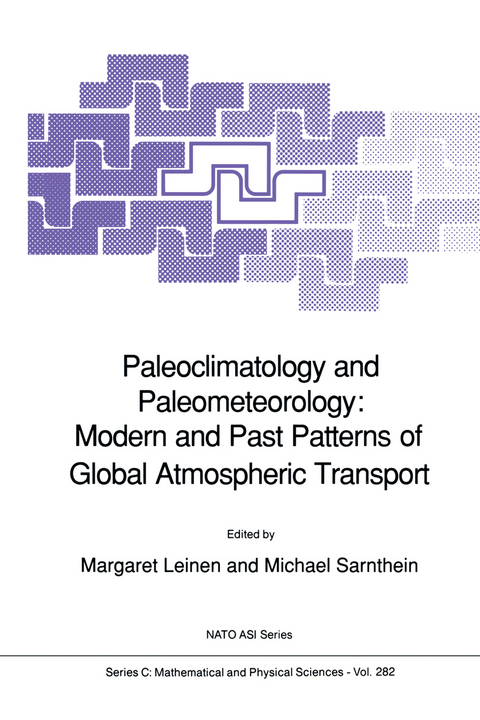
Paleoclimatology and Paleometeorology: Modern and Past Patterns of Global Atmospheric Transport
Springer (Verlag)
978-0-7923-0341-1 (ISBN)
The NATO Advanced Research Workshop on "Paleoclimatology and Paleometeorology: Modem and Past Patterns of Global Atmospheric Transport" (held at Oracle, Arizona, USA from November 17-19, 1987) brought together atmospheric chemists, physicists, and meteorologists who study the origin and transport of modem-day mineral and biological aerosols with geologists and paleobotanists who study the sedimentary record of eolian and hydrologic processes along with modelers who study and conceptualize the processes influencing atmospheric transport at present and in the past. Presentations at the workshop provided a guide to our present knowledge of the entire spectrum of processes and phenomena important to the generation, transport, and deposition of eolian terrigenous material that ultimately becomes part of the geologic record and the modeling techniques that used to represent these processes. The presenta tions on the geologic record of eolian deposition documented our present understanding of the na~e and causes of climate change on time scales of the last glacial ages (tens of thousands of years) to time scales over which the arrangement of continents, mountains, and oceans has changed sub stantially (tens of millions of years). There has been a growing recognition of the importance of global climatic changes to the future well-being of humanity. In particular, the climatic response to human alterations to the earth's surface and chemical composition has led to concern over the agricultural, ecological, and societal impacts of such potential global changes.
Section 1. Dust Formation, Injection, and Continental Aridity.- 1. Processes of fine particle formation, dust source regions, and climatic changes.- 2. Formation of winderodible aggregates for salty soils and soils with less than 50% sand composition in natural terrestrial environments.- 3. Dust and climate in the American Southwest.- 4. Climatic controls on the frequency, magnitude and distribution of dust storms: examples from India/Pakistan, Mauritania and Mongolia.- 5. Emission of fine-grained particulates from desert soils.- 6. Relationships between the characteristics of soils, the wind energy and dust near the ground, in the western sandsea (N.W. Sahara).- 7. Aeolian dust transport in West Africa.- Section 2. Dust Transport and Transport Modeling.- 1. Modeling long-range transport using trajectory techniques.- 2. Present transport and deposition patterns of African dusts to the North-western Mediterranean.- 3. Desert dust and climate: an investigation using an atmospheric general circulation model.- Section 3. Dust Composition and Factors Controlling it: Evidence from Aerosols and Sediments.- 1. Eolian dust over the Mediterranean and their contribution to the present sedimentation.- 2. Eolian dust collected in springtime (1979 and 1984 Years) at the seawater-air interface of the Northern Red Sea.- 3. Desert aerosol: characteristics and effects on climate.- 4. Local, proximal and distal Saharan dusts: characterization and contribution to the sedimentation.- 5. Atmospheric mineral dust — properties and source markers.- 6. Nd and Sr isotopes as tracers of wind transport: Atlantic aerosols and surface sediments.- 7. Wind-borne deposits in the Northwestern Indian Ocean: record of Holocene sediments versus modern satellite data.- 8. Aeolian-derived higher plantlipids in the marine sedimentary record: links with palaeoclimate.- 9. Lithogenic sediment on Arctic pack ice: potential aeolian flux and contribution to deep sea sediment.- Section 4. Modeling Atmospheric Circulation in the Past.- 1. Past and present oceanic energy balance patterns.- 2. Possible effects of orbital variations on past sources and transports of eolian material: estimates from general circulation model experiments.- Section 5. Inferences from the Sedimentary Record: Loess, Ice Cores, and Other Land Evidence.- 1. Climatic changes in Israel during historical times and their impact on hydrological, pedological and socio-economic systems.- 2. The mineral-dust record in a highaltitude Alpine Glacier (Colle Gnifetti, Swiss Alps).- 3. Fallout of Saharan dust in the Northwestern Mediterranean Region.- 4. Late Quaternary climatic changes in the African Rain Forest: forest refugia and the major role of sea-surface temperature variations.- 5. The regionalization of climatic change in Western North America.- 6. Interglacial environments in presently Hyperarid Sahara: palaeoclimatic implications.- Section 6. Report of the Group Studying: Inferences from the Marine Sedimentary Record.- 1. Northeast Asian climatic change over the last 140,000 years inferred from pollen in marine cores taken off the Pacific Coast of Japan.- 2. The Late Quaternary record of atmospheric transport to the Northwest Pacific from Asia.- 3. Variations of the NW African trade wind regime during the last 140,000 years: changes in pollen flux evidenced by marine sediment records.- 4. Deflation and humidity during the last 700 ka in NW Africa from the marine record.- 5. Palynology of the last 680,000 years of ODP Site 658 (off NW Africa): fluctuations in paleowind systems.- 6. Pliocene history of South Saharan/Sahelian aridity: record of freshwater diatoms (Genus Melosira) and opal phytoliths, ODP Sites 662 and 664.- 7. Cenozoic climatic variation recorded by quartz and clay minerals in North Pacific sediments.- 8. Geologic record of atmospheric circulation on tectonic time scales.- Section 7. Reports and Recommendations of Working Groups.- 1. Dust Formation, Injection, and Continental Aridity.- 2. Dust Transport and Transport Modeling.- 3. Dust Composition and Factors Controlling IT: Evidence from Aerosols and Sediments.- 4. Modeling Atmospheric Circulation in the Past.- 5. Inferences from the Sedimentary Record: Loess, Ice Cores, and other Land Evidence.- 6. Report of the Group Studying: Inferences from the Marine Sedimentary Record.
| Erscheint lt. Verlag | 30.9.1989 |
|---|---|
| Reihe/Serie | NATO Science Series C ; 282 |
| Zusatzinfo | XXI, 909 p. |
| Verlagsort | Dordrecht |
| Sprache | englisch |
| Maße | 160 x 240 mm |
| Themenwelt | Naturwissenschaften ► Geowissenschaften ► Geologie |
| Naturwissenschaften ► Geowissenschaften ► Hydrologie / Ozeanografie | |
| Naturwissenschaften ► Geowissenschaften ► Meteorologie / Klimatologie | |
| ISBN-10 | 0-7923-0341-5 / 0792303415 |
| ISBN-13 | 978-0-7923-0341-1 / 9780792303411 |
| Zustand | Neuware |
| Informationen gemäß Produktsicherheitsverordnung (GPSR) | |
| Haben Sie eine Frage zum Produkt? |
aus dem Bereich


